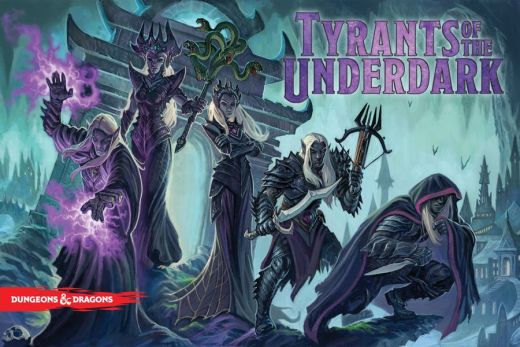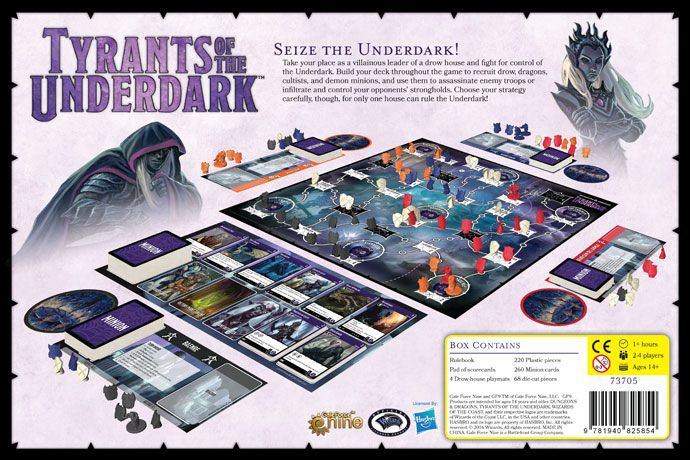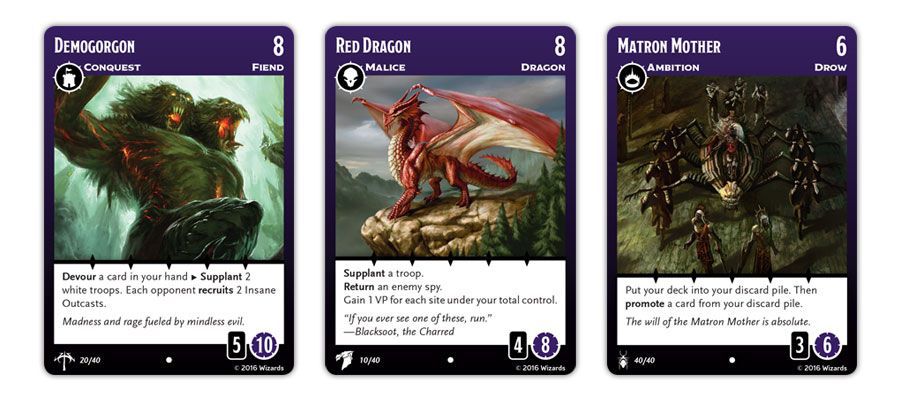Tyrants of the Underdark
In this D&D Board Game, deck building meets area control and it's good. Real good. Check out our review of Tyrants of the Underdark

Posted 30 November 2018 by Jay Kay
- Card Drafting
- D&D
- Deck / Pool Building
- Fantasy
- Games we LOVE
- Hand Management
- Worker Placement
- Set Collection
- Designer(s): Peter Lee, Rodney Thompson, and Andrew Veen
- Playercount: 2 - 4
- Length: 45 - 90 min
INTRO
This game was released in 2016 with what seemed like a big marketing campaign. For reasons beyond us, it seems to have failed somewhat. One reason could be the theme of the game, another the color palette, which for non-D&D fans could be off-putting. But you should never judge a book or a board game by the cover, should you?
Components
- Game board
- Rulebook
- Storage tray
- Pad of scorecards
- 4 Drow-house playmats
- 220 Plastic pieces:
- -160 Player troops (40 for each of 4 colors)
- -40 White (unaligned) troops
- -20 Spies (5 for each of 4 colors)
- 260 Minion cards:
- -28 Nobles
- -12 Soldiers
- -15 House Guards
- -15 Priestesses of Lolth
- -30 Insane Outcasts
- -160 Market cards (four 40-card half-decks)
- 68 Die-cut pieces:
- -40 Tokens, 1 VP
- -16 Tokens, 5 VP
- -7 Site control markers
- -4 Inner-circle boards
- -First Player Token
OVERVIEW
Tyrants of the Underdark is a territory control game combined with a deck builder. Kind of like Kemet and Dominion mixed together, and it's set in the Dungeons & Dragons world of Faerun, in the massive set of caves under the main continent, known as the Underdark;
Each player leads a house of Drow, the "darkelves", in a section of the Underdark. The Drow house is represented by a deck of cards, with each card being a minion in that player's deck. Each minion belongs to one of five aspects of Drow society, and those aspects correspond to different strategies in the game, e.g., malice minions excel at assassinating opponents' troops, while ambition minions are best at recruiting additional minions and promoting minions to your "inner circle", which is a special zone that increases their value at the end of the game.

Set up.
The set up is fast once you get a hang of it, the only problem can be the troop components, which can be a bit fiddly.
You place a number of neutral troops on the map, depending on the number of players.
You shuffle together 2 half-decks of cards, to form a central deck of 80 cards. You will turn 5 cards from this deck face up to form a "marketplace", from which you recruit, "buy", cards.
You give each player a starter deck with 10 cards, 3 soldiers and 7 nobles each. The soldiers generate Power and the nobles generate Influence. Power is used to placing troops on the map, deploying spies, assassinating enemy troops, and getting rid of enemy spies.
Influence is used for buying cards from the marketplace mentioned earlier.

Gameplay
On your turn, you play your cards from your hand, add up your Power to use various actions on the map, use your influence to recruit cards from the marketplace. As cards from the marketplace are recruited, they are immediately replaced with new ones from the central deck.
The marketplace cards obviously have Influence and Power on them, but also special abilities which you cannot use with Power. There are 5 different themes of cards;
Ambition, these cards excel at recruiting more minions (cards) and creating a strong inner circle. The inner circle lets you remove a card from your deck and put it in your inner circle, where it might be worth more points in the end.
Conquest, as the name suggests, these cards are best for taking over the map of the Underdark.
Malice, flexible cards that are best at assassinations.
Guile, used mainly for spies.
Obedience, focus on Power and Influence.
Players take turns fighting over key points on the map, sending spies to establish presence to cities, recruiting various monsters and minions from the market place. This takes about 60-90 minutes depending on the players.
This continues until the marketplace is depleted or one player has exhausted his private troops.
Players score for controlling sites on the map, their recruited minions, the number of enemy troops they have assassinated, and the number of minions promoted to their inner circle, and, not very surprisingly, the player with the highest score is the winner.
OPINION
The good
- Mixes two different types of games (deckbuilding and area control) in a very streamlined way.
- The area control mechanics are very well put together.
- The "Inner Circle" is a new taking on "trashing" cards.
- Easy to grasp and teach.
- Lots of different ways to score points.
- Awesome theme, especially if you like fantasy and/or D&D.
- Scales very well at 2, 3 or 4 players.
The bad, kind of
- The palette, as mentioned earlier, is probably gonna put some people off. But who cares, the game is solid.
- The components, especially the troops are a bit fiddly. The rest is OK, not great, but OK.
CONCLUSION
Overall a VERY solid game, and a very underrated one at that. One of the best games of 2016, if you ask us, which you should.
Rating: 9/10
Files
- Faerun Sword Coast Map Low Res - Map of the famous Sword Coast in Faerun, Forgotten Realms, Low Resolution
- Faerun Sword Coast Map Med Res - Map of the famous Sword Coast in Faerun, Forgotten Realms, Medium Resolution
This game is still aviable on the market, but probably not for long. Pick it up at one of these stores.
Return to Reviews



